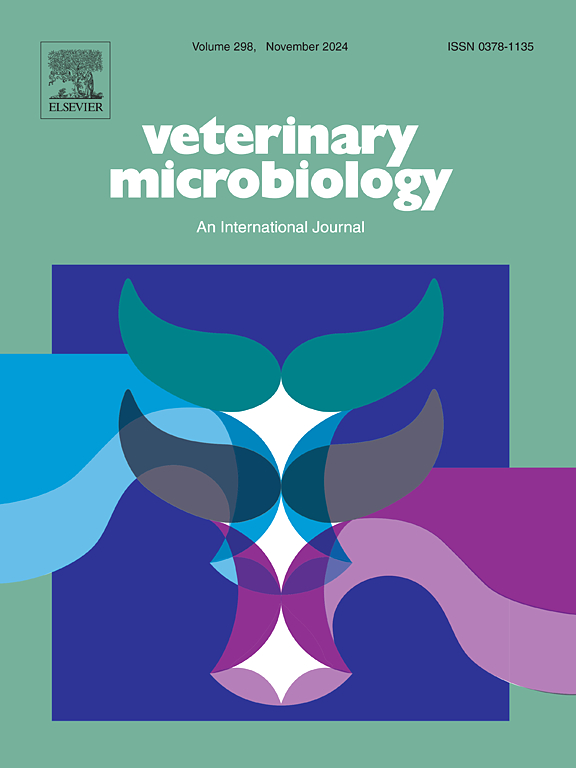荚膜免疫是必要的保护,以防止某些菌株,但不是所有菌株副猪青杆菌
IF 2.4
2区 农林科学
Q3 MICROBIOLOGY
引用次数: 0
摘要
副猪绿脓杆菌是猪Glässer病的病原体,每年给养猪业造成重大损失。由于与许多细菌疫苗相关的血清型和菌株特异性反应,很难产生广泛的异源保护。本研究将未包封的副猪G.突变体(HS069∆cap)作为疫苗进行评估,并与包封的亲本菌株制备的疫苗进行比较,以对抗同源亲本菌株(血清型5)以及四种异源攻击菌株(血清型1、4、5和14)的攻击。HS069和HS069∆cap菌素对同源株和异源株均产生高滴度。HS069∆cap菌素能够对亲本菌株以及12939(血清型1)、2170B(血清型4)和MN-H(血清型13)提供保护,但不能保护动物免受长崎(血清型5)的攻击。相反,HS069菌素能够对所有的攻击菌株提供保护,显示了对长崎攻击菌株的血清特异性免疫的重要性。这似乎是由于与HS069相比,长崎生产的胶囊更丰富,组织更完善。结果表明,HS069∆cap是良好的细菌发育候选菌株;然而,它可能不太能够提供保护,对高度封装菌株副猪螺旋体。本文章由计算机程序翻译,如有差异,请以英文原文为准。
Capsular immunity is necessary for protection against some but not all strains of Glaesserella parasuis
Glaesserella parasuis is the causative agent of Glässer’s disease in pigs and results in significant losses to the swine industry annually. Due to the serovar and strain specific response associated with many bacterin vaccines, there has been difficulty generating broad heterologous protection. Here, an unencapsulated G. parasuis mutant (HS069∆cap) was assessed as a bacterin vaccine and compared to a bacterin made from the encapsulated parent strain, against challenge with the homologous, parent strain (serovar 5) as well as four heterologous challenge strains (serovar 1, 4, 5, and 14). Both the HS069 and HS069∆cap bacterins generated high titers to the homologous and heterologous strains. The HS069∆cap bacterin was able to provide protection against the parent strain as well as 12939 (serovar 1), 2170B (serovar 4), and MN-H (serovar 13), but was unable to protect animals from challenge with Nagasaki (serovar 5). In contrast, the HS069 bacterin was able to provide protection against all challenge strains, showing the importance of serovar specific immunity against the challenge strain Nagasaki. This appears to be due to the production of a more abundant and well-organized capsule in Nagasaki as compared to HS069. This study indicates HS069∆cap is a good candidate strain for bacterin development; however, it may be less able to provide protection against highly encapsulated strains of G. parasuis.
求助全文
通过发布文献求助,成功后即可免费获取论文全文。
去求助
来源期刊

Veterinary microbiology
农林科学-兽医学
CiteScore
5.90
自引率
6.10%
发文量
221
审稿时长
52 days
期刊介绍:
Veterinary Microbiology is concerned with microbial (bacterial, fungal, viral) diseases of domesticated vertebrate animals (livestock, companion animals, fur-bearing animals, game, poultry, fish) that supply food, other useful products or companionship. In addition, Microbial diseases of wild animals living in captivity, or as members of the feral fauna will also be considered if the infections are of interest because of their interrelation with humans (zoonoses) and/or domestic animals. Studies of antimicrobial resistance are also included, provided that the results represent a substantial advance in knowledge. Authors are strongly encouraged to read - prior to submission - the Editorials (''Scope or cope'' and ''Scope or cope II'') published previously in the journal. The Editors reserve the right to suggest submission to another journal for those papers which they feel would be more appropriate for consideration by that journal.
Original research papers of high quality and novelty on aspects of control, host response, molecular biology, pathogenesis, prevention, and treatment of microbial diseases of animals are published. Papers dealing primarily with immunology, epidemiology, molecular biology and antiviral or microbial agents will only be considered if they demonstrate a clear impact on a disease. Papers focusing solely on diagnostic techniques (such as another PCR protocol or ELISA) will not be published - focus should be on a microorganism and not on a particular technique. Papers only reporting microbial sequences, transcriptomics data, or proteomics data will not be considered unless the results represent a substantial advance in knowledge.
Drug trial papers will be considered if they have general application or significance. Papers on the identification of microorganisms will also be considered, but detailed taxonomic studies do not fall within the scope of the journal. Case reports will not be published, unless they have general application or contain novel aspects. Papers of geographically limited interest, which repeat what had been established elsewhere will not be considered. The readership of the journal is global.
 求助内容:
求助内容: 应助结果提醒方式:
应助结果提醒方式:


